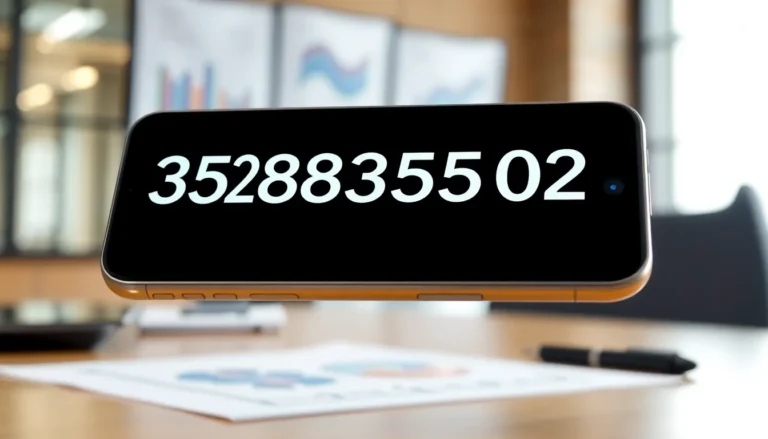In a world overflowing with numbers, one sequence stands out like a unicorn in a field of horses: 2092276224. This seemingly random string of digits is more than just a number; it’s a portal to a fascinating realm of mathematics and technology. If you’ve ever wondered how a simple combination of digits can hold such power, you’re in for a treat.
Picture this: you’re at a party, and someone drops the bombshell that 2092276224 is actually the result of a mind-boggling mathematical phenomenon. Cue the gasps and the raised eyebrows! From prime factorization to its role in computing, this number has a story that’s sure to impress and entertain. Buckle up as we dive into the quirky world of 2092276224 and discover why it deserves a spot in your trivia arsenal.
Table of Contents
ToggleUnderstanding 2092276224
2092276224 is a notable number with fascinating properties and applications. Its significance extends beyond being a simple numerical sequence.
What Is 2092276224?
2092276224 is an integer that plays a prominent role in both mathematics and computing. Factoring this number reveals its prime components, useful for various mathematical explorations. Specifically, it’s expressed as (2^{24} times 3^2 times 7^2). Beyond its mathematical characterization, this number appears in computer science contexts, showcasing its versatility. Recognizing its attributes enables a deeper appreciation for its relevance in technical fields.
Common Uses of 2092276224
In computing, 2092276224 frequently appears in various algorithms and calculations. It often represents data sizes, particularly in binary environments, where powers of two dominate. Network protocols also reference this number for identifying particular ranges and settings, ensuring efficient data transmission. Programmers occasionally employ it in codes and routines to streamline processes. Understanding how it relates to these applications demonstrates its practicality and importance in everyday technology.
Technical Aspects of 2092276224
This section explores the technical characteristics and applications of the number 2092276224. Understanding these aspects reveals its importance in various fields.
The Format of 2092276224
2092276224 is an integer that appears in its standard decimal format. It comprises ten digits, making it a relatively large number. In computing, the binary representation is noteworthy; it converts to 111110110000110000000000. This conversion highlights its structure, as handling binary formats is essential in digital systems. The decimal format allows for easy interpretation in mathematics and assists in various calculations. Additionally, its representation in different numeral systems conveys unique properties relevant to diverse applications in technology.
Significance in Computing
In computing, 2092276224 serves multiple purposes that enhance system performance. Often encountered in algorithms, this number plays a crucial role in calculations that involve data processing and storage. Specific network protocols use it for efficient data handling, resulting in improved reliability and speed. Its prime factorization demonstrates potential for optimization in processing algorithms. The number’s large value often associates it with networking and system limits, where boundary values are critical. Its appearance in performance metrics ensures that systems run optimally, making it a significant figure in computational tasks.
Applications of 2092276224
The number 2092276224 finds diverse applications across various fields, especially in software development and data analysis.
In Software Development
Software developers often utilize 2092276224 in writing efficient algorithms. It plays a pivotal role in optimizing code performance. Many algorithms leverage its binary representation, enhancing processing speed. The number frequently appears in hash functions and checksums, ensuring data integrity during transmission. Developers might incorporate 2092276224 to manage resource allocation effectively, improving application stability. In network programming, its mathematical properties assist in optimizing packet sizes, resulting in better throughput. The number’s large value often signifies upper limits for data structures, guiding developers in designing scalable applications.
In Data Analysis
Data analysts apply 2092276224 when assessing large datasets. It aids in determining thresholds in data processing tasks. Analysts may use its factorization to increase efficiency in computations, providing insights faster. Applications in statistical analysis often include 2092276224 as a benchmark value. Many data processing frameworks consider it when performing calculations that require precise integer values. Additionally, its appearance in algorithmic trading models demonstrates its importance in financial analysis. By using this number, analysts can enhance prediction accuracy and refine their models for better decision-making.
Potential Issues with 2092276224
Understanding potential issues with 2092276224 enhances its application in various fields. Multiple pitfalls can arise during its use, especially in computing contexts.
Common Errors Encountered
Errors often occur due to miscalculations involving 2092276224. Users sometimes misinterpret its binary representation, leading to inaccuracies in data processing. Another frequent mistake involves incorrect usage in algorithms; wrong values may lead to inefficient or faulty outcomes. Additionally, resource allocation issues can result from misunderstandings about its proper applications in network programming. Suboptimal performance in applications can stem from overlooking the significance of 2092276224 when setting thresholds or benchmarks during execution.
Troubleshooting Tips
Addressing issues linked to 2092276224 involves several troubleshooting strategies. Double-checking calculations ensures that errors from misinterpretation do not occur. Verifying binary formats helps maintain accuracy, especially in digital systems that rely on precise representations. Utilizing debugging tools can identify algorithmic errors quickly. When faced with performance drops, revisiting resource allocation settings may uncover underlying problems. Documenting results aids in recognizing patterns that lead to issues and guides future applications effectively.
The exploration of 2092276224 reveals its multifaceted significance in both mathematics and technology. This number serves as a cornerstone in various applications ranging from algorithm design to network protocols. Its prime factorization not only highlights its mathematical properties but also opens doors for optimization in computing tasks.
Understanding 2092276224 equips individuals with the knowledge to navigate potential pitfalls in data processing and algorithm efficiency. By recognizing its importance and applications, one can better appreciate the role this number plays in enhancing technology and improving system performance. Embracing the complexities of 2092276224 ultimately enriches the reader’s grasp of its relevance in the digital landscape.





